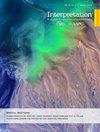鄂尔多斯盆地陇东地区三叠纪延长组长7-3亚段陆相页岩油藏岩相分类及测井识别
IF 1.1
4区 地球科学
Q3 GEOCHEMISTRY & GEOPHYSICS
Interpretation-A Journal of Subsurface Characterization
Pub Date : 2022-12-12
DOI:10.1190/int-2022-0070.1
引用次数: 0
摘要
岩性和岩相的划分与识别在油气藏勘探开发中具有重要意义。岩相信息决定了页岩的发育模式,并提供了有利的“最佳点”层段。鄂尔多斯盆地陇东地区三叠纪延长组长7-3亚段是我国重要的页岩组。岩心照片、铸薄片和测井响应特征用于阐明该地层中各种岩相的发育和分布特征。目标层段的岩相分为细粒砂质碎屑岩、粉砂质至细粒砂质浊积岩、细粒砂质滑塌、半深湖相至深湖相泥岩和深湖相页岩。进一步分析了不同岩相的常规和微电阻率成像测井响应特征。与其他岩相相比,深湖相页岩相具有高伽马射线(GR)、高补偿中子测井(CNL)、高声波测井(AC)和低密度测井(DEN)的特征。提出了GR-AC、DEN-CNL和DEN-AC的交会图来识别大部分岩相,并建立了使用测井图来表征岩相的标准。最后,将常规测井与微电阻率成像测井数据相结合的方法应用于现场井,实现了88%的高准确率。获得了研究区不同岩相厚度的分布图。深湖相页岩面发育面积最广,厚度中心多。准确有效的岩相识别表明,鄂尔多斯盆地内页岩厚度大于6m的面积约为20000 km2,为研究区页岩油勘探提供了重要依据。关键词:陆相页岩油;岩相;湖相页岩;微电阻率成像本文章由计算机程序翻译,如有差异,请以英文原文为准。
Classification and well log identification of lithofacies of continental shale oil reservoirs in Chang 7-3 sub-member of Triassic Yanchang Formation in Longdong area of Ordos Basin, China
The division and identification of lithology and lithofacies are very important in exploration and development of oil and gas reservoirs. Information on lithofacies determines the development modes and provides the favorable "sweet spot" intervals of shales. The Chang 7-3 sub-member of the Triassic Yanchang Formation in the Longdong area of the Ordos Basin is an important shale formation in China. Core photos, cast thin sections, and log response characteristics were used to clarify the development and distribution characteristics of the various lithofacies in this formation. The lithofacies of target intervals are classified into fine grained sandy debrite, silty to fine grained sandy turbidite, fine grained sandy slump, semi-deep to deep lacustrine mudstone, and deep lacustrine shale. Further, the conventional and micro-resistivity imaging log response characteristics of different lithofacies are analyzed. Compared with other lithofacies, deep lacustrine shale facies are characterized by high gamma ray (GR), high compensated neutron log (CNL), high acoustic log (AC), and low density (DEN) log values. Crossplots of GR-AC, DEN-CNL, and DEN-AC are proposed to identify most of the lithofacies, and a criterion was established for use of well logs to characterize the lithofacies. Finally, a method joining conventional logs and micro-resistivity imaging log data was applied to field wells, achieving the very high accuracy rate of 88%. The distribution maps of different lithofacies thickness in the study area are obtained. Deep lacustrine shale faces have the widest development area and many thickness centers. Accurate and effective identification of lithofacies shows that within Ordos Basin, there is an area of about 20,000 km2 with shale thickness greater than 6 m, providing an important basis for shale oil exploration in the study area.Keywords: Continental shale oil; Lithofacies; Lacustrine shale; Micro-resistivity imaging
求助全文
通过发布文献求助,成功后即可免费获取论文全文。
去求助
来源期刊

Interpretation-A Journal of Subsurface Characterization
GEOCHEMISTRY & GEOPHYSICS-
CiteScore
2.50
自引率
8.30%
发文量
126
期刊介绍:
***Jointly published by the American Association of Petroleum Geologists (AAPG) and the Society of Exploration Geophysicists (SEG)***
Interpretation is a new, peer-reviewed journal for advancing the practice of subsurface interpretation.
 求助内容:
求助内容: 应助结果提醒方式:
应助结果提醒方式:


